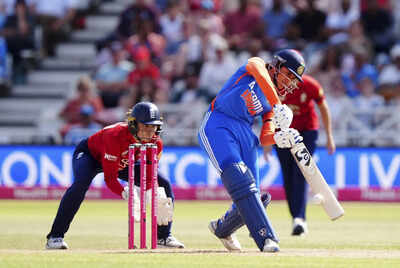Last Updated:
Justice HR Khanna’s stance on ‘Emergency’ to Justice DY Chandrachud’s praise, a look at the full story amid talks of Gandhis’ feud

(Clockwise, from left) Justice HR Khanna, Indira Gandhi and CJI Sanjiv Khanna. (sci.gov.in/File/PTI)
Justice Sanjeev Khanna took oath as the 51st Chief Justice of India (CJI) at a brief swearing-in ceremony held at the Rashtrapati Bhavan on Monday. He succeeds Justice D Y Chandrachud, who demitted office on Sunday.
Apart from President Droupadi Murmu, who administered the oath, and Chandrachud, present on the occasion were Vice-President Jagdeep Dhankhar, Prime Minister Narendra Modi, defence minister Rajnath Singh, union law minister Arjun Ram Meghwal and former CJI JS Khehar.
But more than those present, it was the absence of opposition leader Rahul Gandhi, which stirred a row, with the ruling Bharatiya Janata Party (BJP) tracing it back to how his grandmother and India’s former PM the late Indira Gandhi had taken away the top job from CJI Khanna’s uncle Justice HR Khanna.
Here’s the full story.
WHO WAS JUSTICE HR KHANNA?
Born in 1912, Justice Hans Raj Khanna was appointed as a district and sessions judge in 1952, serving as a judge in the Delhi and Punjab High Courts. In 1971, he became a Supreme Court judge and was considered for the role of Chief Justice of India in 1977.
WHAT WAS THE ADM JABALPUR CASE?
During the Emergency period (1975-1977), on Indira Gandhi’s direction, President Fakhruddin Ali Ahmed had suspended fundamental rights under Article 359. This led to a series of detentions of those opposing the Emergency, including those of Moraji Desai, Atal Bihari Vajpayee, Jayprakash Narayan, LK Advani, in some cases without trials or charges, under the Maintenance of Internal Security Act (MISA). Shivkant Shukla, one of the political activists who was detained, challenged the move, leading to the ADM Jabalpur vs Shivkant Shukla case, commonly known as the Habeas Corpus case.
As the High Courts then ruled that citizens could still approach the judiciary, the Indira Gandhi government moved the Supreme Court.
The Supreme Court bench, including Chief Justice AN Ray and Justices MH Beg, YV Chandrachud, PN Bhagwati, and HR Khanna, debated on whether an order issued by the President under Article 395 (1) of the Constitution suspends the right of people to move any court for enforcement of right to liberty, which falls under Article 21, when detained under a law that provides for preventive detention.
JUSTICE HR KHANNA’S STANCE
The five-judge constitution bench (set up for cases involving important constitutional interpretation) ruled by a 4:1 majority that citizens had no right to seek judicial remedy during an Emergency. The lone dissenting voice was that of Justice HR Khanna.
Justice Khanna argued for the safeguarding of personal liberty, stating that even under Emergency conditions, the rights to life and liberty must remain sacred.
During the hearing, Justice Khanna asked, “In view of his submissions, would there be any remedy if a police officer, because of his personal enmity, killed another man?”
Attorney General Niren De responded, “It may shock your conscience, it may shock my conscience, but consistently with my submissions, no proceedings can be taken in a court of law on that score.”
Justice Khanna said, “… Detention without trial is an anathema to all those who love personal liberty.”
In his autobiography, Justice Hans Raj Khanna later recalled, “…On the night preceding Baisakhi, i.e., on the night of 12th April, we were sitting in the moonlight in the compound of the bungalow while in front of us flowed the Ganges, serene and beautiful. Sitting there and watching the scene, I told my younger sister, ‘Santosh, I have prepared a judgment which is going to cost me the Chief Justiceship of India.’”
In an article in 1976, The New York Times had written: “If India ever finds a way back to the freedom and democracy that were proud hallmarks of its first eighteen years as an independent nation, someone will surely erect a monument to Justice HR Khanna of the Supreme Court.”
INDIRA GANDHI DENIED HIM THE TOP LEGAL POST
In 1977, as Chief Justice AN Ray’s term ended, the Indira Gandhi-led administration passed over Justice HR Khanna, the senior-most judge, and appointed Justice MH Beg as the CJI instead. Justice Khanna resigned the same day after he was informed about the decision over the radio.
After the 21-month Emergency ended and Indira Gandhi’s government fell, he was appointed chairman of the Law Commission, a position he held until 1979. He also briefly served as minister of law and justice under Prime Minister Charan Singh, although he resigned within three days. In 1982, Justice Khanna stood as the opposition’s candidate in the presidential election but lost to Zail Singh.
JUSTICE CHANDRACHUD OVERTURNED HIS FATHER’s ORDER IN ADM CASE, PRAISED HR KHANNA
In 2017, while confirming that right to privacy is a fundamental right, Justice DY Chandrachudas part of a nine-judge SC bench, had overturned the order passed in the ADM case by his father, YV Chandrachud.
He had also praised Justice HR Khanna’s dissentsaying, “The view taken by Justice Khanna must be accepted, and accepted in reverence for the strength of its thoughts and the courage of its convictions.”







